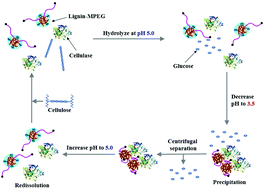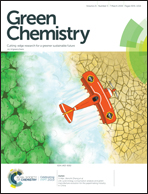Recovering cellulase and increasing glucose yield during lignocellulosic hydrolysis using lignin-MPEG with a sensitive pH response†
Abstract
The conversion of lignocelluloses into fermentable sugars by enzymatic hydrolysis is a key step in biorefining. However, there are still some bottleneck problems such as low hydrolysis efficiency, high cost of cellulase and low utilization of lignin. In this work, the nonionic surfactant monomethoxy polyethylene glycol (MPEG) was grafted on enzymatic hydrolysis lignin (EHL) to obtain a pH-responsive polymer (EHL-MPEG). EHL-MPEG could achieve rapid dissolution–precipitation conversion by the ionization and protonation of carboxyl groups. By adjusting the grafting amount of MPEG, EHL-MPEG could not only enhance the enzymatic hydrolysis of lignocelluloses, but also efficiently recover cellulase after hydrolysis. Adding 3 g L−1 EHL-MPEG40 (the mass ratio of MPEG to EHL was 40%) could increase the glucose yield of corncob residue (CCR) and pretreated eucalyptus from 79.4% and 48.3% to 92.5% and 89.5%, respectively, which was comparable to the effect of the nonionic surfactant PEG4600. By simply adjusting the pH of solutions, more than 85% of cellulase proteins could be recovered by EHL-MPEG40 with almost complete recovery of β-glycosidase, exoglucanase V and xylanase. Compared with a pH-responsive lignin amphoteric surfactant (pH-LAS) obtained by grafting ionic groups on lignin, EHL-MPEG40 had a more sensitive pH response and a stronger cellulase recovery ability. In the enzymatic hydrolysis of CCR, a pH-LAS could save about 50% of cellulase, while EHL-MPEG40 could save more than 60% of cellulase. Furthermore, approximately 96% of EHL-MPEG40 could be reused. This new method can not only evade the process of immobilization, but also avoid the activity loss and component change of cellulase through immobilization. Using recyclable EHL-MPEG to improve glucose yield and recover cellulase during lignocellulosic hydrolysis is of great significance for improving the enzymatic saccharification process, reducing the cost of cellulase and realizing comprehensive utilization of lignocelluloses.



 Please wait while we load your content...
Please wait while we load your content...